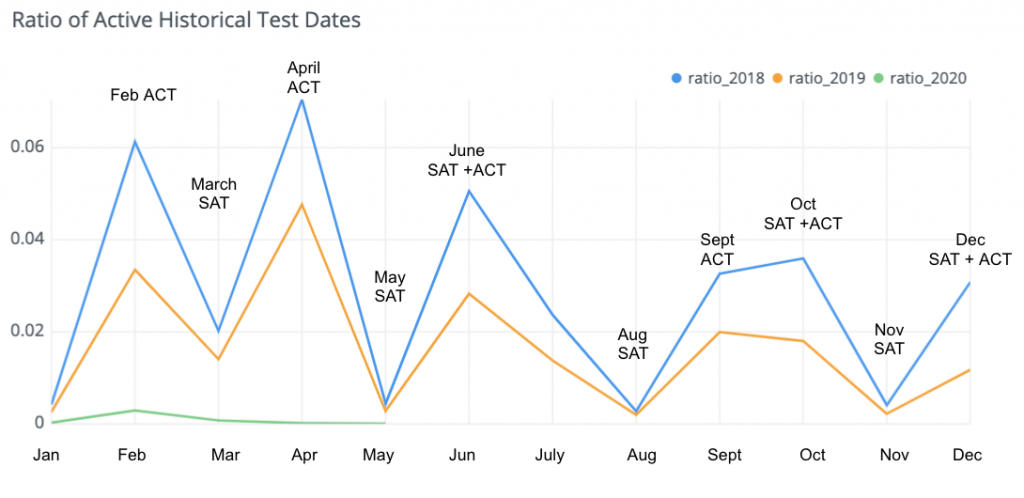A Data-Driven View of Standardized Tests and Higher Ed Admissions
As enrollment leaders consider how to set recruitment strategies for the class of 2021 and beyond, one factor adding additional uncertainty is the rise of test-optional admissions policies. How will this practically impact colleges’ abilities to recruit and engage prospective students? That depends on the magnitude of the impact on test-taking volume.
One of the pieces of information we track on RaiseMe is how many students on the platform are updating their RaiseMe portfolios with standardized test achievements (this is self-reported by the students). Since the start of the pandemic and the increase in schools moving to test-optional policies, we’ve been paying close attention to this data point.
The chart below showcases two important points:
- Test-taking was already on the decline from 2018-2019, with a drop of almost 40% in self-reported standardized test achievements added to portfolios shown YoY.
- The COVID-19 pandemic and the dramatic increase in test-optional transitions appears to have accelerated this trend. The number of students who have added standardized test achievements into their RaiseMe portfolios in 2020 thus far shows a 90% decrease from 2019-2020.

*Data self-reported by students. Many students update their portfolios with standardized test achievements during the summer and in the fall when they go back to school, so we expect 2020 numbers to rise somewhat over the next few months.
It’s important to note that disparity trends YoY were stable–public school students took tests at lower rates than private school students, and low income students took tests at lower rates than peers at higher socio-economic levels.
We believe these results reflect both the impact of the test-optional movement (the trend accelerated in the latter half of 2019, concurrent with the time RaiseMe brought on more partners with test-optional scholarshipping strategies), as well as the COVID-19 pandemic. The recent announcement by the UC System, which is the College Board’s largest client and whose applicants account for 13% of all standardized test takers, will only exacerbate the trends we’re seeing to date.
We anticipate the picture presented in this data will improve a little as school wraps up, students receive test scores, and students update their profiles on RaiseMe to earn micro-scholarships and search for colleges to engage with online over the summer. However, the gap is unlikely to close, and colleges need to be prepared for what this means from an enrollment marketing standpoint.
At times like these, enrollment leaders are reimagining ways to reach students where they are, rather than searching them out. Strategies to consider include diversifying the sources of your student names, investing in “always on” digital experiences, personalizing your message, incentivizing and recognizing students for engagement, switching your medium, and reaching out to prospective students whose names may not be tied to a standardized test score (e.g., freshmen, sophomores, and transfers). You can learn more about tactics which work for UAB, Whittier College, and IUPUI on this webinar.
As we begin to plan “life after COVID” in higher ed, enrollment leaders can get ahead of the trends this data is forecasting and work with partners like RaiseMe to fill enrollment gaps. If you want to talk about how this could work for your school, contact the RaiseMe team here.
You may also like

New York Community College Students Gain Early Access To Transfer Scholarships on RaiseMe
New transfer success initiative will reward students with financial aid awards for strong academic performance, and on-time...

Industry Insights: Reimagining Search in the Time of COVID-19
The higher ed industry is reacting to a rapidly changing student search landscape. In a very short period of time, admission offices across the US shifted tours, events,...

Reimagining Search With RaiseMe
It's time to rethink how your university's enrollment team is utilizing student search next fall in the wake of COVID-19.

 Laura Reisert-Kalinkewicz
Laura Reisert-Kalinkewicz